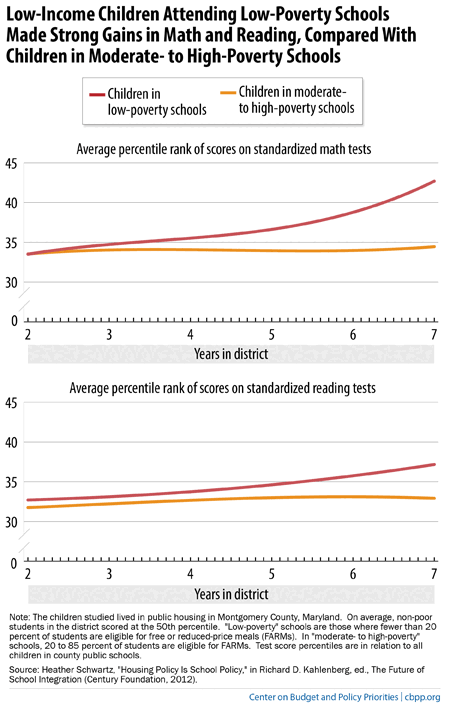BEYOND THE NUMBERS
One Way to Help Poor Kids Do Better in School: Help Their Families Move to Better Neighborhoods
Housing location makes a difference in low-income children’s short- and long-term success, as we detail in our new paper. There’s growing evidence that violent, stressful, high-poverty neighborhoods can compromise children’s cognitive development, school performance, and health — and that low-poverty neighborhoods with high-quality schools improve low-income children’s school performance.
Many studies show strong links between neighborhood (and school) poverty and poor student academic performance. A study led by Harvard University’s Robert Sampson showed, for example, that the verbal skills of children growing up in severely disadvantaged neighborhoods were lower — by an amount equivalent to one to two years of schooling —than those of children in better neighborhoods. And separate studies (here, here, and here) led by New York University researcher Patrick Sharkey concluded that exposure to neighborhood violence can affect kids’ intellectual development.
These studies line up with the burgeoning research about the harmful effects on children of toxic stress, which affects young children’s brain development of in ways that undermine their cognitive skills, and can contribute to long-term health problems such as heart disease. While much of the toxic stress research has focused on the effects of child abuse and family dysfunction, severely disadvantaged neighborhoods — particularly those where violent crime is common — can also contribute.
This leads to the question: if high-poverty neighborhoods hurt kids’ school performance, do low-poverty neighborhoods help? The evidence here is surprisingly complex, as researchers have found it difficult to disentangle neighborhood effects from individual, family, and other influences. But recent research provides strong evidence that low-poverty neighborhoods with high-quality schools can boost children’s achievement.
A rigorous study by RAND researcher Heather Schwartz of low-income children living in public housing in Montgomery County, Maryland, found that:
- Low-income students who lived in low-poverty neighborhoods and attended low-poverty schools made large gains in reading and math scores over a period of seven years, compared with other students living in public housing and attending moderate- or moderately high-poverty schools (see chart).
- These educational gains accrued over time, with the majority of the gains accruing in years five to seven. Residential stability in low-poverty neighborhoods and schools thus appeared to be a crucial condition of the children’s success.
- Students benefited academically from living in low-poverty neighborhoods, but most (two-thirds) of the gains came from attending a low-poverty school.

The research shows that children can benefit from living in neighborhoods that provide better opportunities, but federal rental assistance programs fall short in helping families make such moves. We’ll take a closer look at this challenge — and what federal, state, and local agencies can do to meet it — in follow-up posts.
